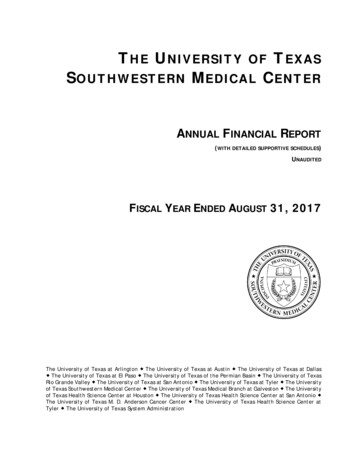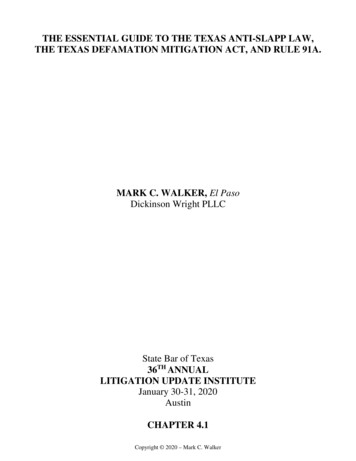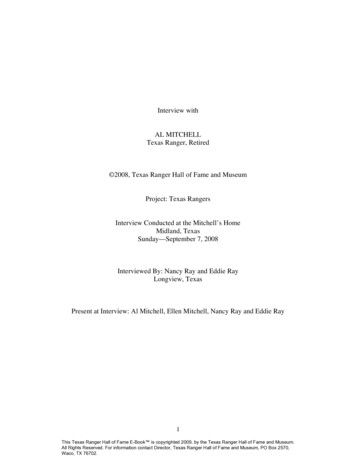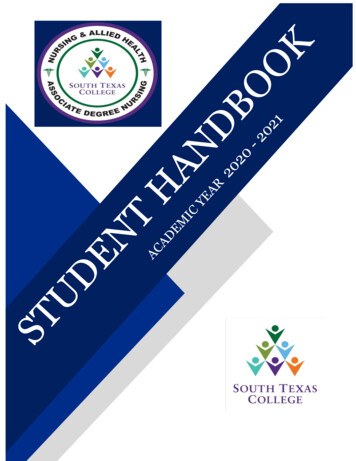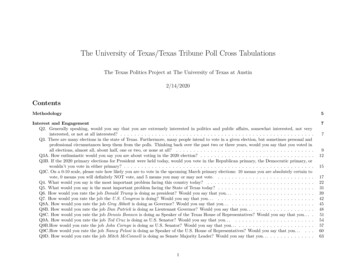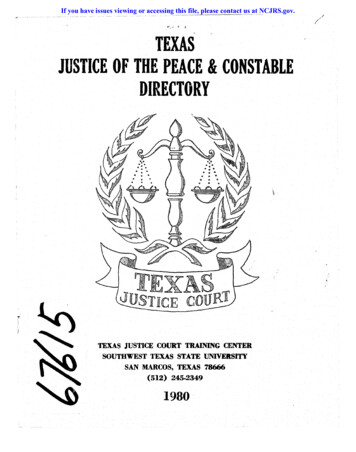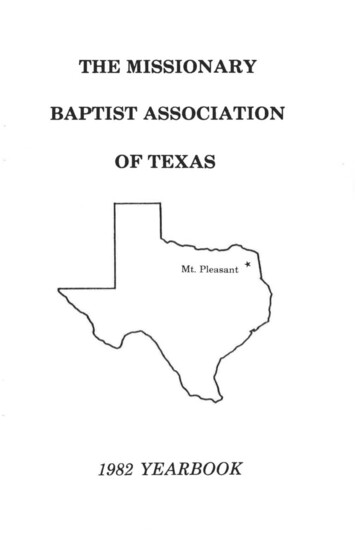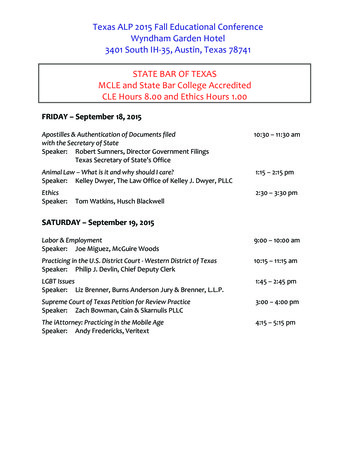
Transcription
Hotel3401SouthIH- tCourt- ericks,Veritext4:15–5:15pm{TALP//03056472.DOCX.1 }
wcases.
9/10/15TEXAS ALP FALL CONFERENCEAUSTINTEXAS2015THOMASHWATKINS Husch Blackwell heprofession2ENTITIESCORPORATIONSLIMITED LIABILITY CORPORATIONSLIMITED LIABILITY PARTERSHIPLIMITED PARTNERSHIPPARTNERSHIP31
9/10/15CHARTS4PIERCE THE CORPORATE VEILBOARD MEETINGSMINUTESNO PROPER SEPARATIONS OF FUNDSOVERLAPPING BOARDS AND OFFICERS5Texas ruleGeneral conflicts 1.06(1) involves a substantially related matter in which that person’s interests arematerially and directly adverse to the interests of another client of the lawyeror the lawyer’s firm; or(2) reasonably appears to be or become adversely limited by the lawyer’sor law firm's responsibilities to another client or to a third person or by thelawyer’s or law firm’s own interests.Not the ABA ruleNot the rule in other statesNot the rule in federal court62
9/10/15TWO RED FLAGSTWO PEOPLE COME IN ON THE FIRST INTERVIEWFEE IS PAID BY SOMEONE OTHER THAN ct.93
9/10/15FutureoftheprofessionA orneysParalegals104
THOMAS H. , TXDirect: 512.703.5752Fax: 512.479.1101INDUSTRY FOCUSTechnology, Manufacturing &TransportationPRACTICE AREASManufacturingTechnologyBusiness LitigationClass ActionIP LitigationTom has practiced full-time litigation for more than 40 years. A member of the firm’sTechnology, Manufacturing & Transportation team, Tom focuses on high-profile, bet-thecompany litigation in healthcare, patent, oil and gas, environmental and general commerciallitigation. His experience on behalf of industry clients includes:Defended a Canadian company in a patent infringement lawsuit filed by a Fortune 100company seeking more than 5 million in damages for control of thetelecommunications splicing market. Case was resolved favorably for client.Represented owner of next-generation technology company relating to the clarity offlat-panel televisions in a lawsuit against a Japanese multinational corporationconcerning compliance with a license agreement.Tom defends numerous legal malpractice cases and serves as an expert witness withregard to the Texas disciplinary rules of professional conduct in numerous cases.ADMISSIONSTexas, 1964U.S. District Court, EasternDistrict of Texas, 2008U.S. District Court, NorthernDistrict of Texas, 2006U.S. District Court, SouthernDistrict of Texas, 1971U.S. District Court, WesternDistrict of Texas, 1965U.S. Court of Appeals, FifthCircuit, 1986U.S. Court of Appeals,Federal Circuit, 1998U.S. Supreme Court, 1996U.S. Tax Court, 1973EDUCATIONLL.B., University of Texas atAustin School of Law, 1964A frequent speaker on industry issues and ethics, Tom has lectured for the State Bar ofTexas, the American Bar Association, the University of Texas Law CLE, the NationalBusiness Institute, Travis County Bar Association, Practicing Law Institute, University ofHouston Law Center, Water Law Institute, Williamson County Bar, Austin Bar, CorpusChristi Bar and the New Mexico Bar.Before joining the firm, he was a partner at Brown McCarroll.Representative ExperienceDefended a California-based startup company against patent infringement andmisappropriation of trade secret claims relating to semiconductor technology used incell phones. Achieved favorable results for client.Defended a Canadian company in a patent infringement lawsuit filed by a Fortune 100company that sought over 5 million in damages/injunction giving it control of thetelecommunications splicing market. Case was tried to a federal court jury, withfavorable verdict invalidating two of plaintiff’s patents due to obviousness andanticipation. Also, jury invalidated several claims of another patent for indefiniteness.Defended the Texas State Board of Insurance in a 22 million attorneys’ fee claim forwrongful prosecution of individuals in an insurance company takedown resulting intake-nothing judgment against the board.Husch Blackwell LLP THOMAS H. WATKINS
B.A., University ofOklahoma, 1962Represented owner of next-generation technology relating to the clarity of flat-paneltelevisions in a lawsuit against a Japanese multinational corporation concerningcompliance with a license agreement between the two. The case was filed in federalcourt in Austin, Texas.Defended a German company in a patent infringement lawsuit filed against it by auniversity and dominant company in the field of rapid prototyping systems using lasertechnology.Represented a municipality in defending an environmental ordinance against a highprofile, media-driven constitutional attack by local developers. Statute ultimatelyupheld by the Texas Supreme Court.Defended legal malpractice/breach of fiduciary duty case in a 30 million claim andforfeiture of a seven-figure contingent attorneys’ fee. Settled the case with apayment of funds to client for his portion of fee for underlying litigation.Represented 1,600 class members in a lawsuit against a developer and lender;obtained settlement approved by the district court, the bankruptcy courtreorganization and a class action settlement approval.Defended client’s 10 million ownership interest involving adverse claim to stockownership in a closely-held corporation among in-fighting shareholders. Wonsummary judgment that was upheld on appeal.Awards and RecognitionsBest Lawyers in America, Bet-the-Company Litigation, CommercialLitigation, Litigation-Environmental, Litigation-Patent, 1989-2016Martindale-Hubbell AV PreeminentState Bar of Texas, Presidential Citation for leadership in improving bar’s grievancesystem, 1999; Gene Cavin Award for Excellence in Continuing Legal Education, 2003State Bar of Texas Foundation, Lola Wright Foundation Award, 1995Texas Center for Legal Ethics, Professionalism Award, 2003Texas Super Lawyers, Business Litigation, 2003-2007, 2009-2014; Top 50,Central/West Texas, 2003-2007, 2009-2014Travis County Bar Association, Distinguished Lawyer Award, 2000Professional Associations and MembershipsAmerican Bar AssociationAmerican Board of Trial AdvocatesAmerican College of Trial Lawyers, fellowAssociation of Trial Lawyers of AmericaAustin Junior Bar Association, president, 1972College of the State Bar of TexasState Bar of Texas, Board of Disciplinary Appeals, chair, 1992-1994; District 9Grievance Committee, chair, 1986-1989; Board of Directors, 1981-1983; CLECommittee, chair, 1992-1995Supreme Court Task Force on Texas Disciplinary Rules of Professional Conduct, chairTexas Trial Lawyers AssociationHusch Blackwell LLP THOMAS H. WATKINS
Texas Commission for Lawyer Discipline, 1995-1999Travis County Bar Association, president, 1979Civic InvolvementFirst United Methodist Church of Austin, Endowment Board, chair, 2008-presentMarch of Dimes, State Advocacy and Government, chair, 2003-presentNational Association of Mental Health, director, 1973; vice president, 1972-1974;president, 1976Texas Association of Mental Health, director, 1968; treasurer, 1969; president, 1970Travis County Mental Health Association, director, 1968; vice president, 1969Publications and PresentationsAuthor, “Ethics: Issues for Eminent Domain Professionals,” CLE International, June2013Author, “Avoiding Malpractice at the Speed of Light: Are Your Email CommunicationsProtected and Secure?” Texas Bar Journal, 2005Author, “Balancing the New Texas Ethics Rules with Federal Ethics Requirements,”Business Bankruptcy course, May 2005Author, “A Rose Is a Rose Is a Rose – Or Is It?” Fiduciary and DTPA Claims AgainstAttorneys, St. Mary's Law Journal, Volume 35, Number 4, 2004Speaker, “Who is the Client?” University of Texas at Austin School of Law, May 2013Speaker, “Ethics Roundtable: Navigating the Challenges,” University of Texas atAustin School of Law, April 2013Speaker, “How to Practice Law Without Selling Your Soul,” Texas State Bar Collegesummer school, 2013Speaker, “Representing Multiple Parties; The Changing Face of Water Rights,”seminar, February 2013Speaker, “Ethics Jeopardy,” Hidalgo County Bar Association, October 2011Speaker, “Knowing Who’s Your Client and Nurturing That Relationship,” State Bar ofTexas, July 2011Speaker, “Fee Agreements: Sandbags Against the Tide,” The University of Texas atAustin School of Law, June 2009Speaker, “Malpractice Issues in the Technology Sector,” The University of Texas atAustin, 2004Husch Blackwell LLP THOMAS H. WATKINS
SPEAKER BIOJoe Miguez is an attorney with the Austin office of McGuireWoods. Prior to joining the firm, heworked as Senior Counsel for Employment Law at Dell. Joe is Board Certified in Labor andEmployment Law by the Texas Board of Legal Specialization, and for the past thirteen years hasfocused his practice almost exclusively on employment law matters. Joe’s substantial experienceincludes not only defending and trying lawsuits, but also working with companies both large andsmall, non-profits, and individuals to help them better understand their legal rights and duties, aswell as assisting businesses of all sizes and types in drafting policies, resolving workplace issues,and effectively training their leaders.Joe graduated cum laude from the University of Georgia School of Law, and is also a proudalumnus of Leadership Austin’s Essential Class of 2014. A resident of Austin, he is a member ofthe City of Austin Human Rights Commission, and also works with several local non-profits,including serving as a member of the Board of Directors of Austin-based AmericanYouthWorks. Before becoming an attorney, Joe served for seven years in the United StatesArmy, where he worked as an intelligence analyst and Arabic language instructor assigned toNational Security Agency.BRIEF OVERVIEW OF TOPICThe law of the American workplace has undergone major changes in the past decade.Employment lawsuits alleging unlawful discrimination, denial of protected leave, and failure topay wages continue to make up a large percentage of the cases in both federal and state dockets.Meanwhile, amid an overall decline in the power of unions, labor leaders and advocates continueto seek new avenues to educate workers and increase membership. Many employers lack theknowledge they need to understand and follow the myriad laws that apply to them.This presentation will not only provide an overview of the various laws and regulations thatgovern employers and employees, but will also cover current trends in labor and employmentlaw, differences between state, local, and federal law, thoughts and observations regarding bestpractices for employers, and even a brief history of how American workplace law has developedover the past century-plus.
A HISTORYOF THEWESTERN DISTRICTOF TEXASLucius D. Bunton, III[Revised: November 1, 2004]
The judges of the Western District of Texaswish to thank the family of our formercolleague and friend, The Honorable Lucius D.Bunton, III, for authorizing an update to“ A H i s t o r y o f t h e W e s t e r n D i s t r i c t o f Te x a s ,”written by the late Judge Bunton.The amendm ents allow for our new judges tobe recognized and our departing judges to behonored. Great care and considerations weretaken to allow the spirit of Judge Bunton’sbook to remain the same.Walter S. Smith, Jr.Chief Judge
IN BRIEFThe Western District of Texas is indeed the most uniquedistrict in the state of Texas, and perhaps even in the UnitedStates. It is the largest district in the United States court systemwhere a state has more than one district. For example, Alaska hasonly one district that comprises the entire state. The WesternDistrict encompasses over 92,000 square miles, which is 4,000miles larger than the state of Utah. It is rich in history, and it hasa fast-growing population.The District is so large that it is in two time zones. Mostof the Western District is in the central time zone, but the twowestern-most counties, Hudspeth and El Paso, are in the mountaintime zone.The Western District has three of the largest cities inTexas. These are greater San Antonio, with a population of overtwo million people, and Austin and El Paso, with populations between a half a million to a million people.Since the District encompasses West Texas, it was the lastpart of Texas to be populated. Indian raids were not uncommonin the Western District even after federal courts had beenestablished.The Western District has the Blue Bell Ice Cream factoryin Brenham; the city where Dr. Pepper originated, which is Waco;the State Capitol of Texas, which is in Austin; the largest bordertown in the United States, which is El Paso. Austin and itssurrounding area is known as the Little Silicon Valley. One of thenation's largest computer manufacturers is located in TravisCounty. The District is proud to have the Alamo, which is inSan Antonio.-1-
The District also has the three largest military installationsin Texas, which are Fort Hood, Fort Sam Houston, and Fort Bliss.It has two national parks, which are Big Bend National Park andGuadalupe National Park.The geography is varied. The Western District has rollinghills near Waco, the Hill Country just west of Austin, ranches thatsurround San Antonio, the Permian Basin oil fields, the mountainsof West Texas, a bit of the Southern Plains, and the rugged beautyfound in the 801,163 acres of Big Bend National Park thatsurpasses anything else in Texas. Elevations range from 190 feetabove sea level in Leon County to the top of Guadalupe Peak inCulberson County, which is 8,749 feet above sea level and thehighest point in Texas. A huge part of the boundary betweenMexico and the United States is the Rio Grande River, which runsfrom El Paso, past Eagle Pass, and then on down to the Gulf ofMexico.The District has less rainfall than the other districts inTexas but produces its share of agricultural products and farsurpasses the other districts in the production of oil and gas.Normal rainfall varies from less than 9 inches in El Paso Countyto more than 40 inches for the counties on the eastern side of theWestern District.The Western District is a district of contrasts. It has rivers,lakes and aquifers. It has desert, cactus, and fields of bluebonnets.It has manufacturing, farms, ranches, learning institutions and thegreatest people anywhere.The geographical location of the Western District of Texasresults in a very heavy criminal docket. The El Paso, Pecos andDel Rio Divisions all border the Rio Grande River, and Mexico isthe principal source of supply for marijuana and cocaine.The Western District has more criminal cases filed thanseven of the Circuits. There were 4,193 criminal casescommenced from October 1, 2002 to September 30, 2003. This ismore than any other district in the United States except for theSouthern District of Texas, which exceeded the Western District-2-
of Texas by approximately 600 cases that year. Per active judge,this results in a docket of over 323 cases per an annum for the 13judges in this Court. Some of these criminal cases have beenhigh-profile cases, such as the Branch Davidian case in Waco.The trial of Charles Harrelson, who assassinated Judge John H.Wood, Jr., garnered a great deal of publicity, as did several of theMexican Mafia trials. Also, the “Quad Mother” murder trial ofAllen Blackthorne in San Antonio received nationwide attention.The Jencks case was tried in El Paso, which resulted the JencksAct. The first criminal trial involving the hijacking of an airplanealso occurred in El Paso.The Speedy Trial Act ensures that all defendants indictedby a federal grand jury receive a speedy trial, and a median timeinterval from indictment to disposition is only 5 months in theWestern District. This is made possible, not only throughhard-working judges, but, with the very capable assistance ofthirteen full-time magistrate judges.This is not to say that the civil docket is not important. Alljudges have a heavy civil docket and statistics reflect that in theFiscal Year ending September 30, 2003, there were 3,334 civilcases filed, and 3285 civil cases terminated. Many of the civilcases are routine tax, discrimination, civil rights, and SocialSecurity appeals. Some of the cases, however, are high-profilecases that have generated much publicity, not only in Texas, but,throughout the nation.All in all, the dockets reflect an extremely heavy caseloadfor our judges. In fact, the active judges in the Western Districtconsistently fall within the top ten federal courts in the country inthe number of weighted filings per judge.-3-
WHERE AND WHENWESTERN DISTRICT DIVISIONSCourt is currently authorized in seven divisions in theWestern District. This has not always been the case.PRE-WESTERN DISTRICTWhen Texas came into the United States in 1845, federalcourt was authorized in only one city in Texas. That city wasGalveston. The first presiding federal judge was John C. Watrous.Six years later, in 1851, Congress authorized federal courtto be held in four cities in Texas. They were Galveston,Brownsville, Austin and Tyler.AUSTIN DIVISIONIn 1857, Congress established the Western and EasternDistricts of Texas. Austin was one of the two judicial seats for theWestern District of Texas. The other was Tyler. The EasternDistrict held court in Galveston and Brownsville.The first term of court in Austin was held on June 1, 1857,and Judge Thomas H. DuVal presided.SAN ANTONIO DIVISIONCongress was busy in 1879. It attached Brownsville to theWestern District and created the San Antonio Division. The firstcourt was held in San Antonio on May 5, 1879, and again JudgeDuVal presided. This city is now our headquarters.-4-
EL PASO DIVISIONIn 1884, Congress established the El Paso Division. Thefirst court was held there on April 6, 1885, and Judge EzekielTurner presided.WACO DIVISIONIn 1900, at the beginning of the Twentieth Century,the Western District consisted of Austin, San Antonio, andEl Paso, along with Brownsville. In 1902, Congress placed theBrownsville Division in the Southern District. In 1902 also, theWaco Division was transferred from the Northern District ofTexas to the Western District of Texas, and the presiding judge onSeptember 22, 1902 was Judge Thomas S. Maxey.DEL RIO DIVISIONThe Del Rio Division was created in 1906. The first courtheld there was on September 6, and again the presiding judge wasThomas S. Maxey.PECOS DIVISIONIn 1913, Congress established the Pecos Division. Thefirst court in the Pecos Division was held March 23, 1914, and thepresiding judge was Judge Edward Meek, from the NorthernDistrict of Texas.MIDLAND/ODESSA DIVISIONThere were no new divisions created in the WesternDistrict until 1967, when the Midland/Odessa Division wascreated. The first court was held in Midland on March 4, 1968,and Judge Ernest Guinn was the presiding judge. The reason it iscalled the Midland/Odessa Division is that the act creating thisdivision specifically provided that court could be held in eitherMidland or Odessa, but if held in Odessa, it would be at no cost tothe government.-5-
1. Opening a case in the wrong divisional office.2. Certificate of service contains wrong information.3. Pleading isn't signed.4. Proposed order is not included.5. Documents are filed in the wrong case.6. Attachments are missing.7. Incorrect documents submitted with filing.8. Attachments are not labeled or are vaguely labeled.9. Documents are scanned incorrectly.10. Selecting the appropriate defendant inmulti-defendant cases.
PHILIP DEVLINI received my bachelor's degree in Business Management from the University ofNorthern Colorado, and my master's degree in Legal Administration from the Universityof Denver, Sturm College of Law. I began my career as a Financial Administrator, thenFirm Administrator for boutique law firms in the Denver area. I joined the Courts in2012 as the Division Manager of the Lubbock Division in the Northern District of Texas.I was hired as Chief Deputy Clerk for the Western District of Texas in November 2014.My wife, three small children and I reside in San Antonio and are active with school andsports activities. In my downtime, I like to think about what it would be like if I had anydowntime.BRIEF OUTLINE OF PRESENTATION Personal Introduction, my history in the court and law firm administration History of the Western District of Texas Brief tutorial of CM/ECF system Special Projects in our court and around the country The Future of the Federal Courts
9/14/15Leadership: What it is, What it isnot, and What role do you playWilliam "Bill" E. Hopkins, Partner Husch Blackwell LLPLeadership Defined§ Generally, “the action of leading a group of people or anorganization.”§ The reality is that if you ask 50 people to defineleadership, you could easily get 50 different definitions.§ Some definitions focus on the person, some on thepurpose and some focus on the group.§ All start in the same direction, and end in successfuloutcomes, but the “middle steps” can be drasticallydifferent, depending on the perspective of the personmaking the definition and their experiences.Leadership Defined (cont'd.)§ The fact is that it really does not matter which definitionor definitions you embrace, as long as you understandthe concepts and how they apply to you and yourspecific situation.§ The most important aspect of true leadership is beinggenuine to who you are, true leadership cannot be fakedor pretended.1
9/14/1530 Ways to Define Leadership§ Article written by: Brittney HelmrichBusiness News Daily Staff WriterJune 19, 2015 10:14 am EST- See more pdefinition.html#sthash.chj4YtkM.dpuf30 Ways to Define Leadership§ "Leadership is having a vision, sharing that vision and inspiringothers to support your vision while creating their own." – MindyGibbins-Klein, founder, REAL Thought Leaders§ "Leadership is the ability to guide others without force into adirection or decision that leaves them still feeling empowered andaccomplished." – Lisa Cash Hanson, CEO, Snuggwugg§ "Effective leadership is providing the vision and motivation to a teamso they work together toward the same goal, and then understandingthe talents and temperaments of each individual and effectivelymotivating each person to contribute individually their best towardachieving the group goal." – Stan Kimer, president,Total Engagement Consulting by Kimer30 Ways to Define Leadership§ "Leadership is the art of serving others by equipping them with training, toolsand people as well as your time, energy and emotional intelligence so that theycan realize their full potential, both personally and professionally." – DaphneMallory, family business expert, The Daphne Mallory Company§ "Leadership is being bold enough to have vision and humble enough torecognize achieving it will take the efforts of many people — people who aremost fulfilled when they share their gifts and talents, rather than just work.Leaders create that culture, serve that greater good and let others soar." – KathyHeasley, founder and president, Heasley & Partners§ "My perspective of a leader is an individual who knows the ins and outs aboutthe business so they can empathize with followers. In addition to being a positiveinfluence on the people they are leading, leadership is about setting the tone,motivating, inspiring, thinking big, and never [giving] up when others feel likequitting." – Alexis Davis, founder and designer, Hoo-Kong by Alexis Davis2
9/14/1530 Ways to Define Leadership§ "A true leader is secure in creating a framework that encourages others to tapinto their own skills and ideas and freely contribute to the whole of the project orcompany." – Judy Crockett, owner, Interactive Marketing & Communication§ "In my experience, leadership is about three things: To listen, to inspire and toempower. Over the years, I've tried to learn to do a much better job listeningactively, making sure I really understand the other person's point of view,learning from them, and using that basis of trust and collaboration to inspire andempower. [It's about] setting the bar high, and then giving them the time andresources to do great work." – Larry Garfield, president, Garfield Group§ "I define leadership as knowing when to be in front to lead and guide a teamduring the journey, and when to step back and let others take the lead. Much likean athlete who knows exactly what position to move to on the field at any giventime, a true business leader understands the delicate balance of how to helpothers become leaders, fuel career ambitions, then give them the chance toshine." – Dan Schoenbaum, CEO, Redbooth30 Ways to Define Leadership§ "Too many people view management as leadership. It's not. Leadershipcomes from influence, and influence can come from anyone at any leveland in any role. Being open and authentic, helping to lift others up andworking toward a common mission build influence. True leadershipcomes when those around you are influenced by your life in a positiveway." – Kurt Uhlir, CEO and co-founder, Sideqik§ "Leadership is when someone is willing to stand up front to be either thetarget or the hero to take responsibility for the success or failure of agiven goal. Not everyone has the guts to be a leader and the [take]personal risks that they may encounter." – Darlene Tenes, founder anddesigner, CasaQ [5 Leadership Weaknesses and How to Fix Them ]§ "Leadership is stepping out of your comfort zone and taking risk tocreate reward." – Katie Easley, founder, Kate Ryan Design30 Ways to Define Leadership§ "A leader is someone who has the clarity to know the right things todo, the confidence to know when she's wrong and the courage to dothe right things even when they're hard." – Darcy Eikenberg,founder, RedCapeRevolution.com§ "Leadership is the behavior that brings the future to the present, byenvisioning the possible and persuading others to help you make it areality." – Matt Barney, founder and CEO, LeaderAmp§ "Leadership is caring more about the cause and the people in yourcompany than about your own personal pain and success. It isabout having a greater vision of where your company is trying to gowhile leaving the path open for others to grow into leaders." – JarieBolander, COO and co-founder, Lab Sensor Solutions3
9/14/1530 Ways to Define Leadership§ "A leader is a person who takes you where you will not go alone." –Susan Ascher, CEO, founder and president, SusanAscher.com§ "Leadership means using one's influence to help guide others insuccessfully achieving a goal without desire for recognition, withoutworry of what others think and with awareness of issues, internal orexternal, that might change the results sought." – Marie Hansen,dean of the college of business, Husson University§ "Leadership is not about finding ways to lead better or to motivateyour team. It's about being there from the beginning as equals andbecoming a mentor when they need you to be one." –MichaelWomack, COO and co-founder, hovelstay.com30 Ways to Define Leadership§ "Leadership styles differ, but at the core, good leaders make the people theyare leading accomplish more than they otherwise would. The most effectiveleaders do this not through fear, intimidation or title, but rather by buildingconsensus around a common goal." – Tom Madine, CEO and president,Worldwide Express§ "A leader is a mix of a visionary and a left brainer — an inspiration to otherswho uplifts one to walk beside him, not behind him. A leader lets go of his/her ego and taps into his soul, consistently stretching himself, challenginghimself, growing within." – Brigitta Hoeferl
College of the State Bar of Texas State Bar of Texas, Board of Disciplinary Appeals, chair, 1992-1994; District 9 Grievance Committee, chair, 1986-1989; Board of Directors, 1981-1983; CLE Committee, chair, 1992-1995 Supreme Court Task Force on Texas Disciplinary Rules of Professional Conduct, chair Texas Trial Lawyers Association



